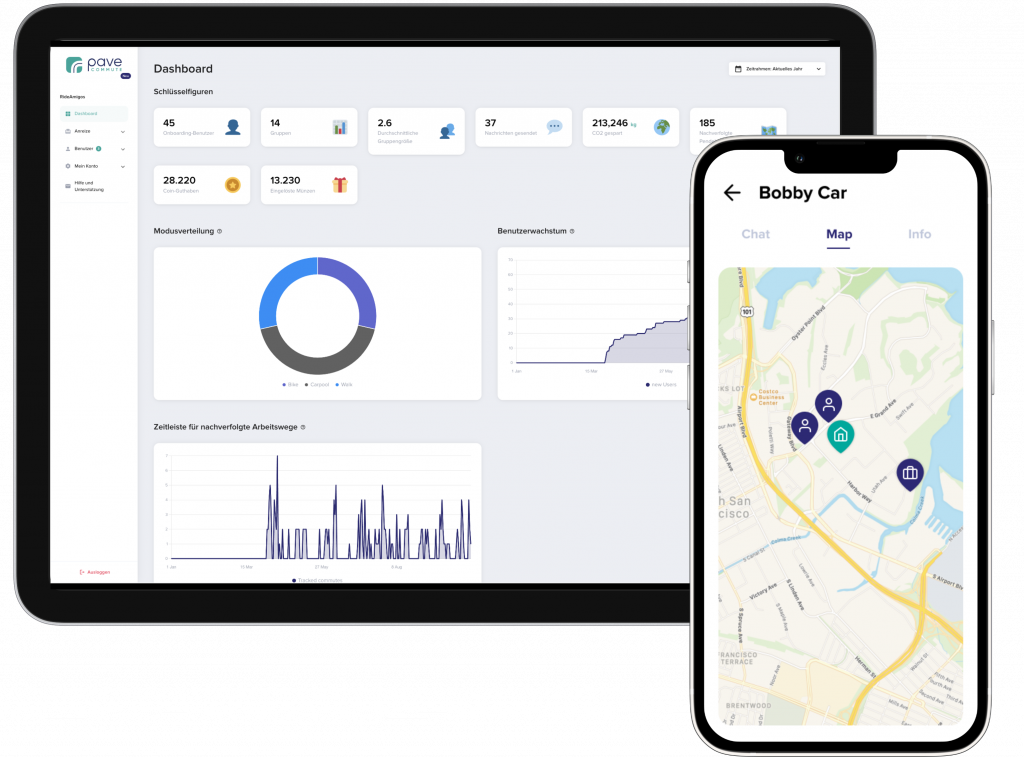High fuel costs, traffic jams, long distances and a shortage of parking spaces often lead to an exhausting daily commute. Many managers are still not aware that the daily commute has problematic consequences for the entire company. This article explains how a lack of employee transportation management can affect your employees’ well-being and reduce the productivity, profitability and competitiveness of your company.
Negative effects of a bad daily commute...
…on employee satisfaction
66% of employees report that their colleagues show stress symptoms due to a bad commute. In New York, people spend 100 hours a year stuck in traffic. Even more on the other side of the Atlantic: In London, Paris and Brussels, drivers spend between 130 and 150 hours a year in traffic jams.
In Germany, 8.6 million people suffer from an increased risk of a heart attack due to mental illness or work-related stress. Evidence is accumulating that this stress is in turn strongly influenced by the commute to work.
...on employee turnover
When employees suffer from a tedious commute and the company doesn’t initiate any employee transportation management initiatives to improve this, there’s a range of potential consequences. Various studies show that one in five workers quits their job because of a poor commute.
The direct turnover costs per lost employee amount to 50-60% of the annual salary. Including indirect costs, the employer incurs costs of 90-200% of the annual salary. Employers mustn’t ignore employee transportation if they want to reduce these costs.
...on employee health and productivity
The health of employees is strongly influenced by their choice of transport on their commute. The widespread lack of physical activity not only leads to more sick leave and thus lower productivity, but also seriously affects employees’ personal well-being.
Researchers agree that active mobility such as walking or biking leads to direct and lasting improvements in health. According to a study, switching from car to bike reduces sick leave by one day per year on average. At the company level, with hundreds or even thousands of employees, this represents great potential to improve employee health and increase their productivity.
...at the expense of both companies and employees
Without proper employee transportation management both employees and employers miss out on cost savings. Owning a car is associated with costs of 894 $ per month. This includes depreciation, repairs and maintenance, insurance, taxes and fuel. Car owners are usually not aware of the alternatives to private cars and how much money they can save.
Employers still interpret company cars as a classic bonus for their staff, although younger generations are increasingly less interested in them. Parking lots require large investments and need ongoing maintenance. The construction costs for an open-air parking lot are in the low five-digit dollar range. In a parking garage or multi-storey car park, the costs roughly double. The ongoing maintenance per year per open-air parking space is in the high three-digit range.
Organizations should look at how they can meet the transport preferences of their workforce in a different, sustainable and modern way. Parking cashout is a great example for good employee transportation management. Parking cashout attracts employees to alternative modes of transport by rewarding them for not using their company parking space. Ultimately, parking spaces can be saved and costs reduced without losing attractiveness for employees.
...on sustainability & decarbonisation
National climate targets, legislation and CO2 reduction paths differ from country to country. Nevertheless, a clear trend towards decarbonisation is emerging. Expectations of companies to cut CO2 emissions are high, but decision makers often lack knowledge of the most appropriate solutions and methods. CSR managers are overwhelmed by the growing amount of data to be included in the sustainability report.
In the medium term, it is to be expected that companies with sluggish sustainability measures will find it more difficult to access fresh capital. The criteria for granting loans increasingly include sustainability criteria in the three pillars of environmental, social and governance. The daily commute of employees plays a role in all three pillars. Therefore employee transportation management should be a fixed item on the sustainability agenda of every company, regardless of the sector.
Any good news about employee transportation?
Even though we are dealing with a complex, gridlocked issue, there is, as always, a flip side to the coin. With dedication, the right strategy and the right tools, you can implement a commuter program that not only minimizes fluctuation in the company and increases employee satisfaction, but also supports productivity and secures the company’s long-term competitiveness. Arrange a meeting with us to find out how!
Sign up your team today!
Try Pave Commute free for 30 days.
No credit card required.










